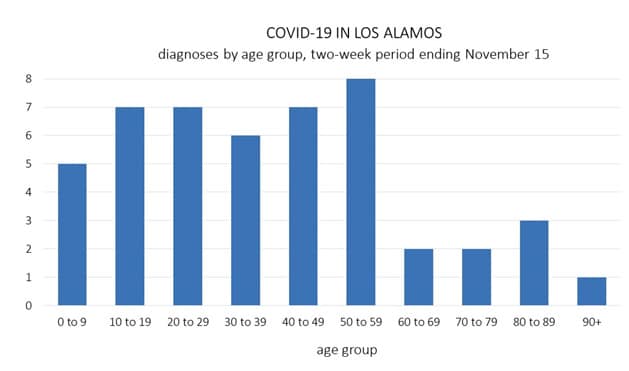 By RICHARD SKOLNIK
By RICHARD SKOLNIK
Los Alamos
Editor’s Note: This is the sixth in a series of COVID-19 Updates by Richard Skolnik that appear bi-weekly in the Los Alamos Daily Post. These are meant to keep the community informed on the status of the pandemic, critical new findings on the pandemic, and what this information suggests for our community’s response to COVID-19. These updates complement the data that Eli Ben-Naim prepares for the Post. Unless otherwise noted, data is from the New York Times and the New Mexico Department of Health.
Pandemic Data and Trends – For the Week Ending Nov. 15, 2021
In the US, the daily average of new cases increased by 14% over the last two weeks. However, hospitalizations fell by 5%, and deaths by 14%. The daily average of new cases in the US over the last week was about 81,000, equal to 26 cases per 100,000 population. Thirty states had increasing rates of new cases.
Over the last two weeks, the daily average of new cases in New Mexico rose by 46%, the sixth highest rate of increase in the country. Hospitalizations rose by 31% and deaths increased by 14%. The daily average number of cases over the last week was 1,383, or 66 per 100,000. This was the third highest number of new cases per 100,000 in the country. Almost 74% of all New Mexicans over age 18 have been fully vaccinated.
Los Alamos had a daily average over the last week of about 3 cases, equal to about 18 per 100,000 population. This was an increase of 71% over the last two weeks. The age distribution of new cases (thanks to Eli Ben-Naim) over the last two weeks is shown in the graphic below. About 92% of the population over 18 years of age in Los Alamos has been fully vaccinated.

COVID-19 diagnosis by age group in Los Alamos for the 2-week period ending Nov. 15. Created by Eli Ben-Naim
Important Pandemic Information
On Nov. 12, the State of New Mexico extended through Dec. 10, 2021, a range of COVID-related measures, including mandates for indoor mask wearing.
That same day, the governor signed an Executive Order making all adults in New Mexico eligible for a COVID booster. NM has joined a number of other states, including Arkansas, California and Colorado, in taking this action.
Presbyterian, the University of NM Hospital, and the San Juan Regional Medical Center in Farmington have enacted “crisis standards of care.”
The LAPS is publishing daily updates of case counts in the schools, including by grade for the elementary schools. These are shown by week and cumulatively for the school year.
Vaccination of children 5-11 with the Pfizer vaccine has begun in the US, including in Los Alamos.
If you are not fully vaccinated in NM, your risk of being infected, hospitalized, and dying is 4.3 times, 5.6 times, and 10.9 times greater than if you are fully vaccinated.
Recent data from Israel, which in many ways is a “COVID pilot study for the world,” saw a dramatic drop in new infections after the provision of boosters, from about 10,000 cases a day to fewer than 1,000 cases a day.
What Should We Do Next in Los Alamos?
Most places in the US have a local or regional public health authority. Those authorities are responsible for assessing local data on the pandemic, using it to refine the local response to COVID, and communicating with the public about COVID. Our county government needs to ensure that local data on COVID is consolidated and assessed, used to refine local approaches to COVID, and that the public gets the information it needs to make safe decisions in our local context. I encourage the county government to urgently fill these critical gaps that constrain our local understanding of and response to COVID.
In line with the programs of the state Public Education Department (NMPED), The Los Alamos Public Schools has begun surveillance testing and a “test and stay” program. Surveillance testing is different from and has different aims than diagnostic testing. Surveillance testing in the schools is a potentially powerful tool for keeping abreast of the pandemic and addressing it more effectively. However, surveillance testing programs need a high degree of community participation to be effective. This, in turn, requires regular, technically sound, and locally appropriate messaging from public authorities and their partners.
Editor’s Note: Richard Skolnik is the former regional director for health for South Asia at the World Bank. He was the director of an AIDS treatment program for Harvard and taught Global Health at the George Washington University and Yale. He is the author of Global Health 101 and the instructor for Yale/Coursera’s Essentials of Global Health. Skolnik has written this article in his personal capacity.

